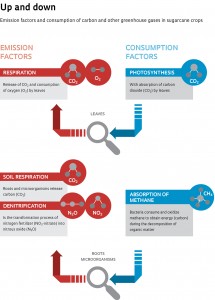 Léo RamosPublished in September 2012
Léo RamosPublished in September 2012
Direct emissions of greenhouse gases from sugarcane plantations are much lower than estimates previously reported in the international scientific literature. This finding is reported in the journal Global Change Biology Bioenergy and is the result of a field study on sugarcane plantations conducted by a group of scientists from different national universities and research centers. The focus of the study was the emission of nitrous oxide (N2O), which is considered to be the most hazardous greenhouse gas, being nearly 300 times more harmful to the environment than carbon dioxide (CO2). In addition, nitrous acid persists for a prolonged time in the atmosphere. Nitrogen-based fertilizers used by farmers to stimulate the growth of sugarcane are the primary source of nitrous acid in sugarcane fields. The results of the field study are important because, if nitrous oxide emissions become excessively high, the environmental benefits of sugarcane ethanol would be questionable. Brazil is the world’s largest sugarcane grower, with an annual production of 596 million tons.
“We established the objective of our research work because of an article by Dutch scientist Paul Crutzen published in 2008. Crutzen won the Nobel Prize for Chemistry in 2005. In his article, Crutzen states that nitrous oxide emission factors in crops that produce biofuels were higher than 3% and could go as high as 5%, directly affecting the planet’s climate as a result,” says agronomy engineer Janaína Braga do Carmo, coordinator of the research study and a professor in the Department of Environmental Sciences at the Federal University of São Carlos (UFSCar) in Sorocaba, São Paulo State. Another prognosis, announced by specialists from the Intergovernmental Panel on Climate Change (IPCC), stated that the emission factor was lower, more specifically, approximately 1%.
“Ours was the first study based on field studies rather than on mathematical models or indirect estimates. Our study showed that nitrous oxide emissions in sugarcane fields in São Paulo State were much closer to the estimates of the IPCC; in other words, the level was much lower than the one stated by Crutzen,” says Janaína. She notes that the study conducted by the Nobel Prize laureate did not refer solely to the ethanol produced in Brazil. That study involved a view of the global production of this biofuel, including ethanol produced from corn and other crops. The emission factor is a measure that expresses the amount of nitrogen released into the atmosphere in the form of nitrous oxide as a proportion of the amount of nitrogen added to the soil in the form of nitrogen-based fertilizer. Nitrous oxide is released into the air by microorganisms in the soil through two processes: nitrification and denitrification.
 Ana Paula CamposThe research study revealed that the emission factor in sugarcane fields fertilized only with nitrogen fertilizers totaled 0.68%. In other words, out of every 100 kilograms of nitrogen used to fertilize crops, 680 grams was transformed into nitrous oxide and “leaked” into the atmosphere. The percentage increases to 3% in areas where vinasse is also used as a fertilizer and where a huge volume of sugarcane waste accumulates in the soil after the sugarcane has been harvested. Vinasse, a residue from sugar and ethanol production, is widely used as a fertilizer in sugarcane fields because of its high potassium content. The sugarcane waste forms a protective layer that reduces soil erosion and water loss. “Our study shows that we have to develop stewardship methods to reduce the emissions associated with using vinasse and sugarcane waste,” says Janaína.
Ana Paula CamposThe research study revealed that the emission factor in sugarcane fields fertilized only with nitrogen fertilizers totaled 0.68%. In other words, out of every 100 kilograms of nitrogen used to fertilize crops, 680 grams was transformed into nitrous oxide and “leaked” into the atmosphere. The percentage increases to 3% in areas where vinasse is also used as a fertilizer and where a huge volume of sugarcane waste accumulates in the soil after the sugarcane has been harvested. Vinasse, a residue from sugar and ethanol production, is widely used as a fertilizer in sugarcane fields because of its high potassium content. The sugarcane waste forms a protective layer that reduces soil erosion and water loss. “Our study shows that we have to develop stewardship methods to reduce the emissions associated with using vinasse and sugarcane waste,” says Janaína.
Treatment-related differences
The research study coordinated by Janaína is part of the FAPESP Bioenergy Research Program (Bioen), which also involves researchers from the University of Maryland in the United States, the Agronomy Institute (IAC), the Center of Sugarcane Technology (CTC), the Nuclear Energy in Agriculture Center of the University of São Paulo (Cena/USP), Embrapa Meio Ambiente, the Federal Rural University of Pernambuco (UFRPE) and the Paulista Technology Agency.
The researchers quantified greenhouse gas emissions in eight sugarcane plantation treatments, each of which utilized a different fertilization method. In the municipal region of Jaú, which is located 300 kilometers from the capital city, the experiments were conducted on plant cane crops. For these crops, the soil is prepared to open the furrows in which the stands will be placed. At this point, the farmer normally adds 60 kilograms of nitrogen, in the form of urea, per hectare. In the region of Piracicaba, 165 kilometers from São Paulo, the focus was on ratoon cane, the phase that comes after the sugarcane has been cut for the first time. At this point, no soil preparation is necessary, and 100 to 150 kilograms of nitrogen fertilizer, usually ammonium sulfate or ammonium nitrate, is used per hectare. In Jaú, the crops were fertilized with urea, vinasse, filter cake—a residue of the sugarcane industry composed of crushed bagasse and mud—or a combination of the three. In Piracicaba, the researchers studied the effect of sugarcane waste on the soil. The four soil treatments used in this municipal region included different quantities of waste: 0, 7, 14 and 21 tons per hectare. The level of emissions was examined for each treatment, both with and without vinasse.
 “Our calculations indicate that the highest percentage (3.03%) of the N2O emission factor in all the experiments and treatments was observed in the plant cane crop (Piracicaba) treated with vinasse and with the highest quantity of sugarcane waste on the surface of the soil – 21 tons per hectare,” the research study specified. “In the case of the plant cane crop, treatment with vinasse plus synthetic fertilizer showed the highest emission factor (2.65%). Without the vinasse, the percentage dropped to 1.1%.” The lowest emission factor, 0.68%, was observed in the experiment that involved the ratoon cane crop, where treatment did not include sugarcane residues, vinasse or filter cake and the crop was fertilized only with nitrogen fertilizer. “Our field study showed that nitrous oxide emissions are insignificant with this kind of treatment. If the estimates predicted in the literature had been correct, the environmental damage caused by the nitrous oxide wouldn’t have been offset by the consumption of carbon caused by photosynthesis and by the sugarcane’s high energy efficiency,” said Janaína. In addition to evaluating the N2O emission factor, the researchers also calculated the total emissions of the three main greenhouse gases: nitrous oxide, carbon dioxide and methane. To compare the effect of these emissions in the various experiments and treatments, the researchers converted the emissions of these three gases into CO2 equivalents, which is the measure used to compare emissions of various greenhouse gases and is based on the global warming potential of each gas. The global warming potential of nitrous oxide, for example, is 296 times greater than that of carbon dioxide. The CO2 equivalent of a given emission source is therefore the result of multiplying the number of tons emitted by the greenhouse gases (GEE).
“Our calculations indicate that the highest percentage (3.03%) of the N2O emission factor in all the experiments and treatments was observed in the plant cane crop (Piracicaba) treated with vinasse and with the highest quantity of sugarcane waste on the surface of the soil – 21 tons per hectare,” the research study specified. “In the case of the plant cane crop, treatment with vinasse plus synthetic fertilizer showed the highest emission factor (2.65%). Without the vinasse, the percentage dropped to 1.1%.” The lowest emission factor, 0.68%, was observed in the experiment that involved the ratoon cane crop, where treatment did not include sugarcane residues, vinasse or filter cake and the crop was fertilized only with nitrogen fertilizer. “Our field study showed that nitrous oxide emissions are insignificant with this kind of treatment. If the estimates predicted in the literature had been correct, the environmental damage caused by the nitrous oxide wouldn’t have been offset by the consumption of carbon caused by photosynthesis and by the sugarcane’s high energy efficiency,” said Janaína. In addition to evaluating the N2O emission factor, the researchers also calculated the total emissions of the three main greenhouse gases: nitrous oxide, carbon dioxide and methane. To compare the effect of these emissions in the various experiments and treatments, the researchers converted the emissions of these three gases into CO2 equivalents, which is the measure used to compare emissions of various greenhouse gases and is based on the global warming potential of each gas. The global warming potential of nitrous oxide, for example, is 296 times greater than that of carbon dioxide. The CO2 equivalent of a given emission source is therefore the result of multiplying the number of tons emitted by the greenhouse gases (GEE).
In both plant cane and ratoon cane, the highest CO2 equivalents were associated with the use of vinasse. In the case of plant cane, the critical emission levels of CO2 equivalents (1,380 kilograms per hectare per year) were achieved when urea, filter cake, and vinasse were used. In the case of ratoon cane, the worst scenario occurred when vinasse was used together with 21 tons of waste per hectare. In this situation, 3,000 kilograms of CO2 equivalents per hectare per year were generated.
Projects
1. N2O, CO2 and CH4 emissions from agro-biofuel production in São Paulo State, Brazil – no. 2008/55989-9; 2. Nitrogen nutrition of sugarcane with fertilizers or diazotrophic bacteria – no. 2008/56147-1. Modality 1. Young Investigator Award for the FAPESP Bioenergy Research Program (Bioen); 2. Bioen Thematic Grants. Coordinators 1. Janaina Braga do Carmo – UFSCar; 2. Heitor Cantarella – IAC. Investment 1. R$ 237,330.83 and US$ 67,054.00 (FAPESP); 2. R$ 957,280.37 and US$ 75,853.15 (FAPESP)
Scientific article
CARMO, J.B. et al. Infield greenhouse gas emissions from sugarcane soils in Brazil: effects from synthetic and organic fertilizer application and crop trash accumulation. Global Change Biology Bioenergy. On-line, 26 Jul. 2012.
